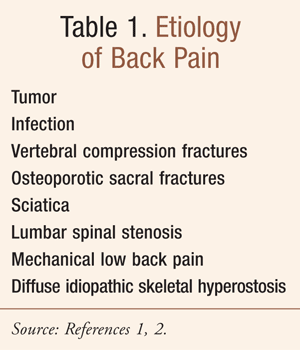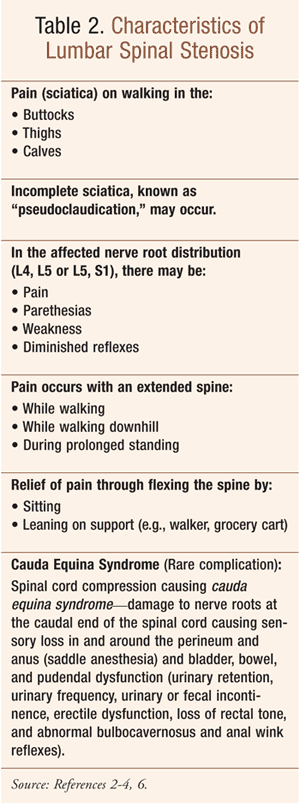US Pharm. 2011;36(3):20-23
Back pain is one of the most frequent complaints for which clinicians assess patients, and low back pain is a common problem among seniors.1,2 According to epidemiologic studies, the prevalence of back pain in older adults ranges from 6% to 47%.2 Low back pain is associated with poor outcome, and consumes a significant percentage of health care resources.2 It is not surprising to note that the etiology, natural history, and therapy of low back pain in seniors are not well defined—most studies that helped to outline the natural history and outcome of back pain were conducted exclusively in patients less than 60 years of age.2
Spinal stenosis, a narrowing of the spinal canal, causes pressure on nerve roots and may involve the cervical or lumbar spine.3 This condition may be acquired or congenital, and risk factors include age and inherited conditions. While lumbar spinal stenosis (LSS) is most common in men and women over 50 years of age, it can occur in younger individuals who have a congenitally narrow spinal canal or who have sustained injury to the spine.4
Although back pain may have a multiple etiology (Table 1), this column will focus on LSS and its characteristics (Table 2), which include positional back pain and nerve root compression. Acquired LSS is a common cause of sciatica in seniors.3

Frequently, diagnostic images in older adults reveal a narrowing of the lateral aspect of the vertebral canal, in addition to the anterior-posterior diameter of the canal.2 The only time these findings have clinical significance is when the typical characteristics of LSS are also present (Table 2).2

Spinal stenosis most often results from a gradual, degenerative aging process.4 Age-related causes include osteoarthritis, disk degeneration, and ossification of the posterior longitudinal ligament; the latter causes formation of calcium deposits on the ligament running up and down behind the spine and inside the spinal canal, pressing on nerves in the spinal canal.4 Other causes of spinal stenosis include spinal tumors, spinal trauma, achondroplasia (resulting in dwarfism), and Paget’s disease.4 While rheumatoid arthritis is not a common cause of spinal stenosis, the damage it causes to ligaments, bones, and joints that initiates as synovitis interferes with joint function and may contribute to this disorder.4
Symptoms and Signs
It is possible for an individual to have a narrow space within the spinal canal and remain asymptomatic; however, if pressure develops on the spinal cord, cauda equina (a collection of spinal roots descending from the lower spinal cord and occupying the vertebral canal below the cord), or nerve roots, there may be an insidious onset and progression of symptoms.4 Usually, patients with LSS experience pain in the buttocks, thighs, or calves on walking, running, climbing stairs, or just standing.3 Pain is not relieved by standing still, but rather by flexing the back (i.e., the spine). This can be observed in patients sitting or leaning on a walker or grocery cart.2,3 While flexing the back relieves pain, it may not alleviate paresthesias.3 Walking downhill, where the back is extended, causes more pain than walking uphill, where the back is flexed.
Patients with LSS may experience sciatic pain on walking. Sciatica occurs if the narrowed space within the spine causes nerve root compression; pain radiates along the course of the sciatic nerve, most frequently down the buttocks and the posterior aspect of the leg to below the knee.3,4 In patients with LSS, however, classic sciatic pain may be incomplete, presenting as calf pain known as “pseudoclaudication” syndrome.2 True claudication is differentiated from this simulated intermittent claudication by skin atrophy and by pulse abnormalities, capillary refill, and vascular testing; brisk peripheral pulses help the clinician exclude peripheral vascular disease as a diagnosis.3 When sciatica develops as part of the LSS syndrome, patients experience gradual progression of pain with shorter and shorter periods of standing and walking.2
In rare cases, spinal cord compression of the cauda equina may result in cauda equina syndrome, a severe form of spinal stenosis; this condition is outlined in Table 2.3,5,6
Diagnosis
Data indicate that the clinician cannot depend on imaging studies to diagnose the cause of back pain in elderly individuals.2 Of note, MRI of the lumbar spine often indicates anatomical abnormalities in individuals without symptoms; this finding is seen particularly among the elderly.2 The patient is suspected to have LSS based on the presence of characteristic symptoms (Table 2). Imaging studies are used to confirm a diagnosis that has been indicated by the history and physical examination in conjunction with the clinician’s knowledge of applied anatomy.2 While an x-ray is not likely to confirm the diagnosis of spinal stenosis, it may be helpful to rule out a fracture, tumor of the bone, or inherited defect.5 If the history and physical suggest a tumor or infection, a complete blood count and an erythrocyte sedimentation rate are considered reasonable screening tests.2
Usually, MRI is the imaging test of choice in the diagnosis of spinal stenosis because it produces cross-sectional images of the spine and can detect disk and ligament damage and tumors; further, it has the ability to show pressure on the spinal cord or spinal nerves.5 A CT myelogram, performed with contrast medium injected into the spinal column, is capable of revealing herniated disks, bone spurs, and tumors.5
Management
Nonsurgical treatments and indications for surgical intervention are similar to those for sciatica.
Nonsurgical, Conservative Approaches: The clinician and patient may find it difficult to choose a nonsurgical approach when developing a care plan for the management of LSS, since there are few randomized controlled trials of these therapies.2 Generally, when OTC analgesics, such as acetaminophen (limit dose <4 g/day; risk of hepatotoxicity and nephropathy) and nonsteroidal anti-inflammatory drugs (high risk for adverse effects in elderly such as gastrointestinal hemorrhage, renal toxicity, central nervous system effects) are ineffective or inappropriate, prescription agents targeting neuropathic pain may be prescribed.
Certain tricyclic antidepressants or anticonvulsants may be prescribed for LSS. Since no tricyclic is superior to another,3 desipramine is the preferred agent in the elderly due to its milder side-effect profile (e.g., sedation, anticholinergic effects)7; usually it is administered nightly to provide restful sleep and minimize daytime drowsiness. Desipramine for neuropathic pain (unlabeled use) in adults is dosed initially at 10-25 mg/day orally, with increases every 3 days as necessary until the desired effect is achieved; the usual effective dose is 50-150 mg/day (maximum dose 150 mg/day).7
Other agents for neuropathic pain include gabapentin (unlabeled use),5 most commonly dosed at 300-1,800 mg/day, orally, given in three divided doses,7 or pregabalin (unlabeled use)5 150 mg/day in divided doses (50 mg 3 times a day), with an increase within 1 week based on tolerability and effect (maximum dose 300 mg/day). 7
Epidural corticosteroid injections, while used for more than 5 decades for sciatica, have had inconsistent results for LSS based on randomized, controlled trials.2 They may be useful, however, when injected into the space where constriction of nerve roots causes irritation and swelling, helping to reduce inflammation and relieve pressure; this modality treats acute pain that radiates to the hips and down the leg.4,5 It has been suggested that, since epidural corticosteroid injections can weaken adjacent bones and connective tissue, they be reserved for pain that is severe or persistent.3,5 Temporary pain relief may also be attempted through the use of anesthetic injections, also referred to as nerve blocks.4
Physical therapy is used to build muscle strength and endurance (e.g., abdominal and back), maintain flexibility and stability of the spine, improve balance, and help control pain.4,5 For patients with weak abdominal muscles or seniors with degeneration at several levels of the spine, a lumbar brace or corset may provide support and help with regaining mobility.4
Lifestyle and home remedies for LSS include the use of canes or walkers to provide stability and relief of pain by allowing the patient to bend forward (i.e., flexing the spine) while walking.5 Losing excess weight assists with reducing additional stress on joints and the bones of the lower back.5
Surgery: Surgery may be considered if conservative approaches to management have failed to achieve the desired effect, symptoms have caused disability, or the patient is in otherwise good health.5 Surgery to relieve pressure on the spinal cord or nerve roots may be performed via a laminectomy (removing the back part [lamina] of the affected vertebrae) to create a larger space within the spinal canal; in some cases, vertebral fusion is sought to maintain the strength and stability of the spine.5
While surgery helps reduce symptoms of spinal stenosis in most cases, some patients experience worsening symptoms after surgery.5 Risks associated with spinal stenosis surgery include infection, meningeal tear, deep venous thrombosis, and neurologic deterioration.5
Conclusion
Low back pain is a common problem among older adults, is associated with poor outcome, and consumes a significant percentage of health care resources. LSS, one of the etiologies of back pain, occurs most frequently in those over the age of 50. As it is a common cause of sciatica in seniors, pharmacists should be familiar with the typical characteristics of LSS and the recommended conservative and surgical interventions.
REFERENCES
1. Marras WS. Occupational low back disorder: causation and control. Ergonomics. 2000;43(7):880-902.
2. Cooney LM Jr. Back pain and spinal stenosis. In: Halter JB, Ouslander JG, Tinetti ME, et al, eds. Hazzard’s Geriatric Medicine and Gerontology. 6th ed. New York, NY: McGraw-Hill; 2009:1471-1477.
3. Beers MH, Porter RS, Jones TV, et al. The Merck Manual of Diagnosis and Therapy. 18th ed. Whitehouse Station, NJ: Merck Research Laboratories; 2006:328,1910.
4. Questions and answers about spinal stenosis. National Institute of Arthritis and Musculoskeletal and Skin Diseases. April 2009.
http://www.niams.nih.gov/
5. Spinal stenosis. MayoClinic.com. March 11, 2010.
http://www.mayoclinic.com/
6. Dorland’s Pocket Medical Dictionary. 28th ed. New York, NY: Elsevier Saunders; 2009.
7. Semla TP, Beizer JL, Higbee MD. Geriatric Dosage Handbook. 16th ed. Hudson, OH: Lexi-Comp, Inc; 2011: 30-33,445-447,766-768,869-873,
To comment on this article, contact Rob Davidson@rdavidson@
uspharmacis






